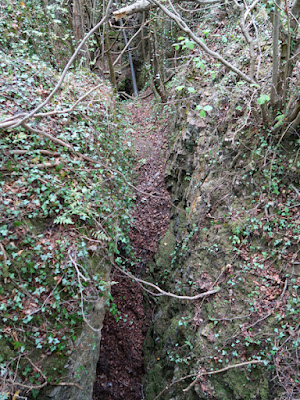At the Sheffield U3A Geology Group indoor meeting in January 2022, when the field trip itinerary for the coming year was discussed, the plan of our group leader Paul – who had been suffering badly from sciatica - was to try encourage more of the 40 plus members to step forward and organise and lead our walks.
Being the youngest member of the Group and its only geologist, I had already led several field trips and I was more than happy to help other members with their recces – starting with a trip to Ashover in the first week of May with Dave, who had assisted with site clearance in Conisbrough and Doncaster earlier in the year.
I first visited Ashover as an undergraduate geologist back in 1979 which, with a periclinal dome revealing an inlier of Lower Carboniferous rocks, is considered to be a classic field trip location. My next trip was 40 years later, when I set out to visit All Saints church as part of my continuing investigation of the mediaeval churches in and around South Yorkshire.
 |
| Various field trip locations around Ashover |
On the latter occasion, I went to look for a couple of the sites that are listed in Geological Excursions in the Sheffield Region, including Butts Quarry, the first location that we visited after parking at a convenient place in the village.
 |
| Butts Quarry |
There is a good exposure of the Eyam Limestone Formation and the underlying Monsal Dale Limestone Formation, which is notably darker in colour – both of which we had seen during our previous field trip to Lathkill Dale. Although we didn’t study any of the rock faces, the quarry is considered to be a good fossil collecting site and there is well developed iron staining along some of the joint planes, which in places have what appear to be slickensides.
 |
| Possible slickensides |
Although not undertaken here, lead mining was once a very important and profitable industry in Ashover and having a quick rummage through some of the piles of waste rock, I found several examples of fluorite and, although I didn’t see any, there is also galena, barytes and calcite too - all of which are common minerals in the lead rakes and associated veins.
Returning to Ashover, Dave then led the way to the water filled Fall Hill Quarry, seen from the footpath above its northern boundary and to which, we later discovered when walking up Hockley Lane in search of the cutting at Hockley Quarry, there is no public access.
Quite unexpectedly, we found one of many old lime kilns that are marked on the 1884 Ordnance Survey map, where there is an excellent exposure of the Fallgate Volcanic Formation – consisting of coarse to fine grained beds of green and purple tuff.
As an undergraduate geologist at Nottingham University, I spent 6 weeks mapping the andesitic lavas, tuffs and ignimbrites of the Ordovician Borrowdale Volcanic Group around Derwentwater and I was therefore very interested to see these.
Making our way up the path past another limestone quarry on the south side of the valley near Fallgate, the lead mining history is apparent in the form of a narrow and deep cleft, where a mineral vein was once worked.
Retracing our steps back to Jetting Street, where there are more lime kilns, a building plot had been excavated into a bed of pale green tuffaceous limestone at the base of the Monsal Dale Limestone Formation, which indicates that the volcanic ash was deposited in water where limestone was being formed.
It proved quite difficult to obtain a sample with my 20 oz Estwing hammer, with this limestone being very hard. Examining it with a hand lens, it is seen to be very crystalline and grains of green chlorite scattered throughout the body of the stone give the rock its pale green colour.
At the same site, there is also a bed of green softer rock, which the geological memoir records at the nearby Milltown Quarry as being green toadstone clay, which is interbanded with the tuffaceous limestone. This weathered basalt was very friable and, not having a sample bag with me, I didn’t collect a sample.
After making our way back to Ashover, having had a good 6.5 km walk, Dave suggested that we should take advantage of the Old Poets Corner public house, where I enjoyed an excellent pint of Everards Tiger, which I hadn’t tasted for nearly 30 years.
We ended our recce by driving up to Ashover Rock, a very popular landmark known locally as the Fabrick, which is an isolated crag of Ashover Grit on the north-east side of the inlier, from which there is a clear view of the anticline that we had just explored.
The massive beds of the Ashover Grit produce a top quality building stone, which has been quarried extensively along the Derwent Valley, between Stanton in Peak and Matlock. Massive sandstone can be seen in the upper part of the crag, but these are underlain by flaggy beds that are much less resistant to weathering and I obtained a couple of small samples from these.














No comments:
Post a Comment